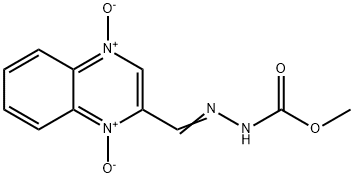-
Name
Carbadox
- EINECS 229-879-0
- CAS No. 6804-07-5
- Article Data10
- CAS DataBase
- Density 1.447g/cm3
- Solubility Soluble in 1N NaOH (50 mg/ml), and water (partly).
- Melting Point 239-240 ºC
- Formula C11H10 N4 O4
- Boiling Point 405.47°C (rough estimate)
- Molecular Weight 262.225
- Flash Point 18°(64°F)
- Transport Information
- Appearance
- Safety Moderately toxic by ingestion. Questionable carcinogen with experimental carcinogenic effects. Human mutation data reported. When heated to decomposition it emits toxic fumes of NOx.
- Risk Codes R45;R11;R22
-
Molecular Structure
-
Hazard Symbols


- Synonyms Carbazicacid, 3-(2-quinoxalinylmethylene)-, methyl ester, N,N'-dioxide (7CI); Carbazicacid, 3-(2-quinoxalinylmethylene)-, methyl ester, N1,N4-dioxide (8CI);Hydrazinecarboxylic acid, (2-quinoxalinylmethylene)-, methyl ester,N,N'-dioxide; Hydrazinecarboxylic acid,[(1,4-dioxido-2-quinoxalinyl)methylene]-, methyl ester (9CI); 2-Formylquinoxaline-1,4-dioxidecarbomethoxyhydrazone; Carbadox; Fortigro; GS 6244; Getroxel; Mecadox; Methyl3-(2-quinoxalinylmethylene)carbazate N1,N4-dioxide;Quinoxaline-2-carbomethoxyhydrazone 1,4-dioxide
- PSA 101.61000
- LogP 1.77760
Synthetic route
-
-
6804-07-5
methyl 3-(2-quinoxalinylmethylene)carbazate N1,N4-dioxide

| Conditions | Yield |
|---|---|
| With sodium dithionite; acetic acid at 26 - 33℃; for 1h; |
Carbadox Chemical Properties
Molecular Structure of Carbadox (CAS NO.6804-07-5):

EINECS: 229-879-0
IUPAC Name: Methyl N-[(E)-(1-hydroxy-4-oxidoquinoxalin-4-ium-2-ylidene)methyl]iminocarbamate
Molecular Formula: C11H10N4O4
Molecular Weight: 262.221500 g/mol
XLogP3-AA: 0.3
H-Bond Donor: 1
H-Bond Acceptor: 6
Canonical SMILES: COC(=O)N=NC=C1C=[N+](C2=CC=CC=C2N1O)[O-]
Isomeric SMILES: COC(=O)N=N/C=C/1\C=[N+](C2=CC=CC=C2N1O)[O-]
InChI: InChI=1S/C11H10N4O4/c1-19-11(16)13-12-6-8-7-14(17)9-4-2-3-5-10(9)15(8)18/h2-7,18H,1H3/b8-6+,13-12?
InChIKey: BPMVRAQIQQEBLN-OBPBNMOMSA-N
Index of Refraction: 1.647
Molar Refractivity: 65.92 cm3
Molar Volume: 181.2 cm3
Surface Tension: 60.7 dyne/cm
Density: 1.44 g/cm3
Melting Point: 239-240 °C
Water Solubility: 1755 mg/L at 25 °C
Storage Temp.: 2-8 °C
Carbadox History
In early 2004, Carbadox was banned by the Canadian government as a livestock feed additive and for human consumption and also banned by the European Union at any level. It is approved in the United States for use in swine for up to 42 days before slaughter.
Carbadox Toxicity Data With Reference
| 1. | dns-hmn:oth 50 mg/L | JTEHD6 Journal of Toxicology and Environmental Health. 10 (1982),143. | ||
| 2. | mnt-mus-orl 100 mg/kg | MUREAV Mutation Research. 144 (1985),81. | ||
| 3. | orl-rat LD50:850 mg/kg | CKFRAY Ceskoslovenska Farmacie. 30 (1981),26. | ||
| 4. | orl-mus LD50:2810 mg/kg | CKFRAY Ceskoslovenska Farmacie. 30 (1981),26. |
Carbadox Safety Profile
Safety Information of Carbadox (CAS NO.6804-07-5):
Hazard Codes: F  ,T
,T 
Risk Statements: 45-11-22
R45:May cause cancer
R11:Highly flammable
R22:Harmful if swallowed
Safety Statements: 53-45
S53:Avoid exposure - obtain special instructions before use
S45:In case of accident or if you feel unwell, seek medical advice immediately (show the label whenever possible.)
RIDADR: UN 1325 4.1/PG 2
WGK Germany: 3
RTECS: FE2779000
Moderately toxic by ingestion. Questionable carcinogen with experimental carcinogenic effects. Human mutation data reported. When heated to decomposition it emits toxic fumes of NOx.
Carbadox Specification
Carbadox with CAS Registry Number of 6804-07-5 is yellow crystalline solid. When heated to decomposition, it yields Carbon monoxide , Carbon dioxide , and Nitrogen oxides. Carbadox is also known as Carbadox [USAN:INN:BAN] ; 2-Formylquinoxaline 1,4-dioxide carbomethoxyhydrazone ; 3-(2-Chinoxalinylmethylen-1,4-dioxid)methylkarbazat ; 3-(2-Chinoxalinylmethylen-1,4-dioxid)methylkarbazat [Czech] ; CCRIS 3002 ; Carbadoxum ; Carbadoxum [INN-Latin] ; Fortigro ; GS 6244 ; Getroxel ; HSDB 7028 ; Hydrazinecarboxylic acid (2-quinoxalinylmethylene)-, methyl ester N(sup 1),N(sup 4)-dioxide ; Karbadox ; Karbadox [Czech] ; Mecadox ; Methyl 3-(2-quinoxalinylmethylene)carbazate N(sup 1),N(sup 4)-dioxide ; Methyl 3-(2-quinoxalinylmethylene)carbazate-N1,N4-dioxide ; UNII-M2X04R2E2Y ; Carbazic acid, 3-(2-quinoxalinylmethylene)-, methyl ester, N(sup 1),N(sup 4)-dioxide ; Hydrazinecarboxylic acid, (2-quinoxalinylmethylene)-, methyl ester N(sup 1),N(sup 4)-dioxide ; Hydrazinecarboxylic acid, (2-quinoxalinylmethylene)-, methyl ester, N,N'-dioxide (9CI) . It is used as antimicrobial to prevent and treat dysentery in swine and to maintain weight gain during periods of stress. It is also used as pharmaceutical excipient, feed additive.
About|Contact|Cas|Product Name|Molecular|Country|Encyclopedia
Message|New Cas|MSDS|Service|Advertisement|CAS DataBase|Article Data|Manufacturers | Chemical Catalog
©2008 LookChem.com,License: ICP
NO.:Zhejiang16009103
complaints:service@lookchem.com Desktop View
